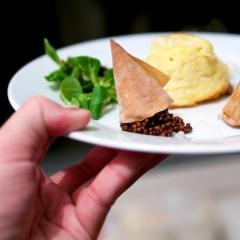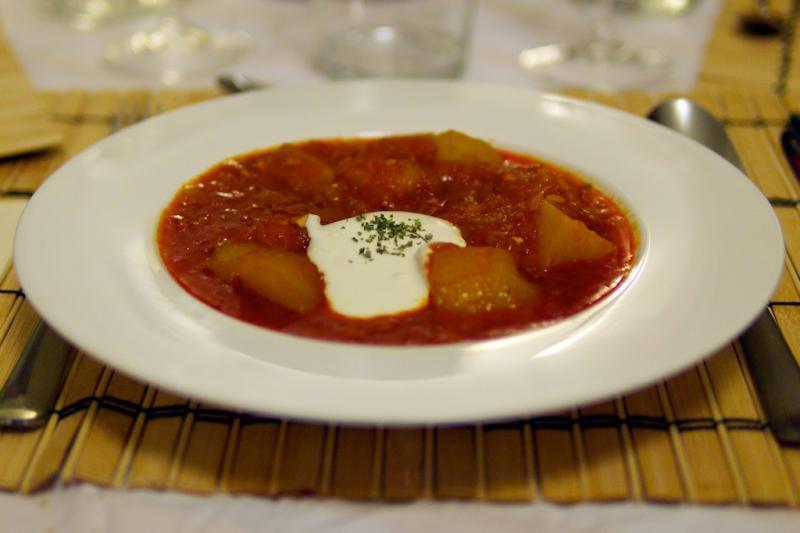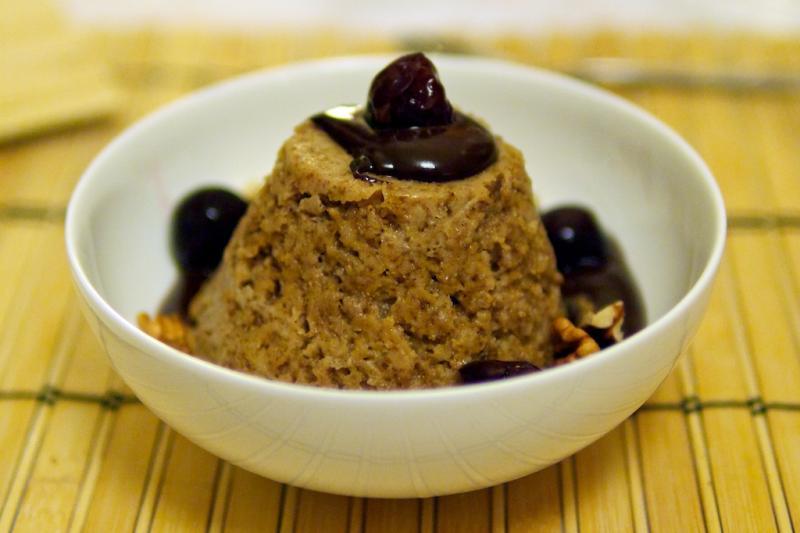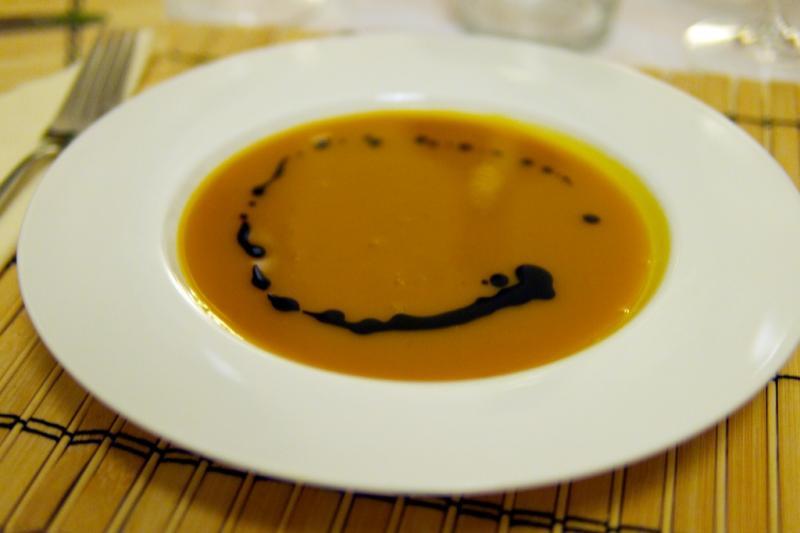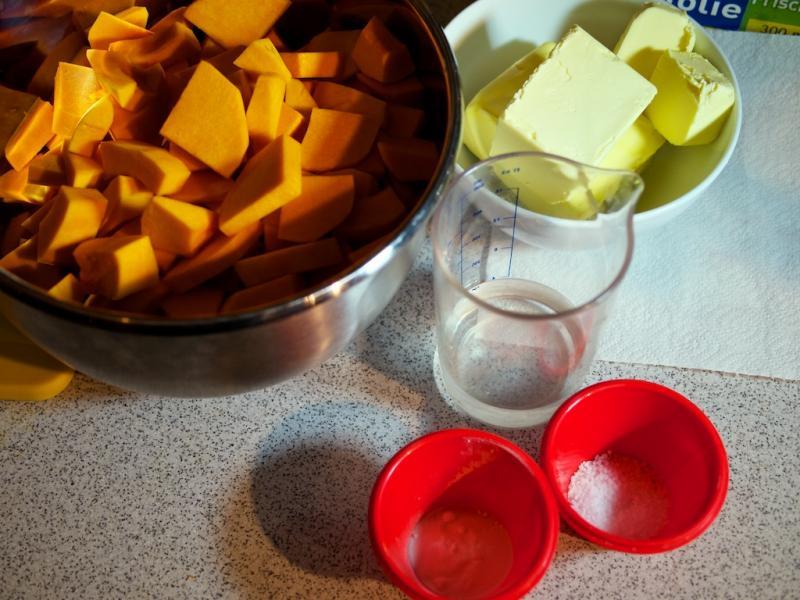-
Posts
346 -
Joined
-
Last visited
Content Type
Profiles
Forums
Store
Help Articles
Everything posted by pep.
-
How long do the pressure-cooked vegetable purees keep? I've got some caramelized beet root puree sitting in the fridge since a bit more than a week. Still usable? It has been kept in a Lock & Lock box, not vacuum sealed. Normally I would have frozen it long ago, but unfortunately, I seem to have forgotten to this time.
-
Since I'm in the process of making some Seville orange liqueur, I've got a question regarding the water used to make the syrup for diluting the alcohol: Most recipes I've found tell you to use distilled water. Is there any specific reason for this if your tap water is good (i.e. not hard, not heavily chlorinated)?
-
I finally have a blog post about the making of that pheasant pâté en croûte online. All in all, I made a lot of mistakes, but I think it was worth it. Terrines are far easier, though, and great to do sous-vide (with vacuum bagging, you don't need to press the terrine). http://mundschenk.at/pate-en-croute-de-faisan/ (The blog is in German, but the pictures should speak for themselves.)
-
Are you talking about white or green asparagus? For relatively thin green asparagus, MC recommends 15 minutes at 85 °C. For the thicker white asparagus, I prefer 25 minutes at the same temperature.
-
For you charcuterie guys out there: Will fresh sausages stand up to the stress of vacuum packing? And if you are at it, what's the best temperature for cooking sausages? Is 70 °C too high? I've got a bunch of different sausages from my local butcher - some are pre-cooked, but two batches are freshly made raw Bratwürste (which should be good just cooked and not pan-fried).
-
Just the water weight of the meat? The MC equlibrium brining uses the whole weight of the protein (without bones, naturally) IIRC. This makes more sense to me, as you want to achieve a certain salinity for the whole product, not just its water content?
-
Yes. Staying at the side of the container is basically the same as floating at the surface: one side of the product is not heated up properly. SV timings would normally be calculated for even heat transmission from all sides.
-
My colander has pretty small holes, but unless I'm making a lot of stuff (in this case: pre-clarification yield of 2.4 kg of SV vegetable stock), I use the ISI strainer to filter out chunks before using a (non-gold) coffee filter or a cheese cloth (since I'm out of coffee filters). I also own a large and small superbag, but cleaning them is no fun and the 100 microns are still to big to do anything truly useful with them. Anyway, I misjudged the concentration necessary for a an agar gel because my brand (Biozoon) contains some maltodextrin to prevent clumping. Using 0.2 %, things stayed liquid even after chilling. I wanted to add some more Agazoon when I noticed that the particles seemed to have acted as nuclei for the (very, very weak) agar gel, so I just filtered it through my cheesecloth again. Voilà! A lot of crystal clear broth, a bit of not so clear broth (resulting from agitating/pressing the cheesecloth a bit too much, although I anticipated that and changed vessels beforehand) and a little bit of dark grey goo ;-)
-
Yes, I've been wanting to get one of those for some time now. Alternatively, I've been thinking about getting this (the 30 oz. one).
-
My concerns were more tastewise. I decanted and tried the vegetable stock just now and it is very good. Having no comparison, the celery notes seem to be a bit too much in the foreground for my liking (but as the stock will be the basis of a beetroot consommé, it doesn't matter much. Unfortunately, for my main stock I poured everything out of the bag into a double cheese cloth in a colander and let it drip through. It appears that the weight of vegetables was enough to press small particles through the cloth. I had an additional bag of leftover trimmings that I filtered differently: I just cut the opposite corners of the bag and let the stock drip out without the actual vegetables coming into contact with the cheese cloth. The second stock was crystal clear while the first one is somewhat cloudy. I guess i'll have to do agar clarification now
-
Wow! That must have been one bad meal!
-
Because it's all already bagged and in the water bath (which can sit unattended, in contrast to the pressure cooker). It's already 00:30 am overhere.
-
Ah, posted in the wrong thread - it's from the original MC (probably quite similar, though). Anyway, 3 am is not a fun time to be woken up to do kitchen stuff ;-) I'm mainly concerned about overextraction from the spices, and maybe about cooking the vegetables to a complete mush, making straining more difficult. On the other hand, the recipe calls for an additional 30 minutes in a hot ultrasound bath, as well as 12 hours of refrigerated extraction. So five hours at 85 °C may just replace the 12-and-a-half in the original recipe ...
-
I'm doing the SV vegetable stock for the first time and have just realized that it's getting a bit late. Any harm in letting the bags in the waterbath overnight instead of 3 hours?
-
Thanks, I find that reassuring (both that I didn't imagine the smell and that it is normal result of the process). It would have been an expensive experiment otherwise (even though I only bought lobster heads for this recipe, the price was pretty outrageous - almost US$ 12 per pound. Another question regarding this recipe: You talk about saving the "lobster jus" remaining under the butter. In my case, this is liquid is a pretty dark greyish brown from particles of Maillardized lobster meat. Is there a simple way to clarify this jus without sacrificing the flavor (as one would with an eggwhite raft)? I mean, besides the obvious centrifuge ;-)
-
I've made the pressure-cooked crustacean butter today, but I'm unsure if everything has turned out as it should. I used raw frozen lobster heads which I blanched and cleaned (eyes, gills, organs). I melted the butter, added the baking soda and the cut up shells and cooked it for an hour on high pressure. After cooling down naturally, I opened the lid. All the remaining lobster meat is browned (obviously from the baking soda fostered Maillard reaction). What put me off a bit is the smell, which to my nose contains a hint of ammonia (my girlfriend did not notice that, however). We both tasted a knife-tip full of the actual butter and it seems to be fine. Am I imagining things, is that smell a normal byproduct of the process or did something go wrong?
-
Anything that goes through the (not very fine) ISI sieve won't be a problem. Vanilla seeds are fine in the ISI whips.
-
You can use it for something else (risotto?), but a significant part of its flavor will be in the butter. To maximize the aromatic "impact" of the soup, you should use fresh juice to thin the puree.
-
No, those are from my mother. Unfortunately, she didn't get any good sour cherries this year, so last year's batch is all I have until summer
-
Vegetarian dinner for 5: Caramelized butternut squash soup with pumpkin seed oil (based on MC@H) Erdäpfelgulasch ("potato goulash") Walnut pudding with bitter chocolate sauce and sour cherries in brandy
-
Yesterday I made the butternut squash variation of the caramelized carrot soup. I thought I had a package of coconut milk in my pantry, but I was mistaken. Therefore I eschewed lemongrass and went somewhat traditional Styrian with the spices - just nutmeg. In an attempt to lighten the richness, I also added a bit of freshly juiced ginger after the pressure cooking step. Finished with Styrian pumpkin seed oil. I think the substitutions worked quite well, but I'm keen on doing it again with the coconut milk and the lemongrass.
-
I've done some experiments with SV goulash a while back. My exploits are documented in http://forums.egullet.org/index.php?/topic/138631-Modernist-Goulash.
-
You don't like pistachios? I'm tempted to say "but they are the best part", but that's not quite true. I do think they add a nice textural element, though. I love to use pistachios also, but my chef is allergic to tree nuts so 95% of the time I have to substitute to get that textural feel. whole or slightly crushed pumpkin seeds seem to work the best. Coarse ground pumpkin seeds tend to meld into the pate too much and sunflower seeds are a little too small also, perhaps roasted and used sparingly with confeed gizzards and hearts they would work well though. With pistachios, I think it's not just the textural element, but also the color. Sunflower seeds or even other nuts simply won't stand out the same way. Pumpkin should work in that regard, though. Personally, I would not crush them for use in a terrine or pâté.
-
You don't like pistachios? I'm tempted to say "but they are the best part", but that's not quite true. I do think they add a nice textural element, though.


